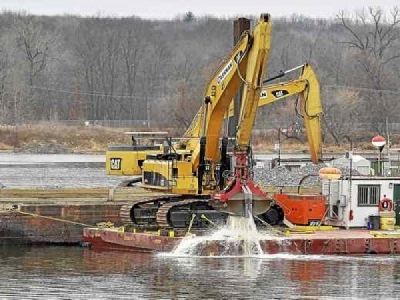
Posted on September 29, 2016
By William J. Kemble, Daily Freeman
The U.S. Environmental Protection Agency will hold a local forum Oct. 13 regarding General Electric’s recently completed dredging of PCB contamination in the Hudson River and the status of monitoring in the past year.
The forum will begin at 4 p.m. in the Henry A. Wallace Visitor and Education Center at the Franklin D. Roosevelt historic site on U.S. Route 9.
“We’re going to be discussing the five-year review process, we’re going to be discussing the purpose of the review and … the data we have for fish, water and sediment,” said Larisa Romanowski, a spokeswoman for the federal agency.
Under orders from the EPA, General Electric dredging the upper Hudson River for several months per year from 2010 to 2015, removing soil from the river bottom that’s laden with polychlorinated biphenyls, or PCBs, that were dumped into the water from two upstate GE plants from 1947 to 1977. PCBs, which the company used as coolants in electrical equipment, were banned by the federal government in 1977 as a suspected carcinogen.
The five-year review process is the second being studied by the federal agency, which in October 2015 declared GE had completed dredging required under a 2002 order. The company has reported removing 310,000 pounds of PCB-laden sediment from a 40-mile stretch of the Hudson River above the Troy Dam.
“There has not been a sign-off on anything at this point other than to say GE has completed the work that was required by the EPA,” Romanowski said.” There’s something that’s called a ‘certificate of completion,’ and that has not yet occurred.”
Under the agency’s declaration of the Hudson River as a Superfund site, the area of concern includes the lower Hudson River extending to New York City.
GE spokesman Mark Behan said the record should show there has been a significant reduction in the level of PCBs in the Upper Hudson.
“The EPA declared [dredging] a success,” he said. “In fact, called it a national model and historic achievement, and we’re now in the first formal post-dredging review.”
The environmental group Scenic Hudson, however, has been critical of reports from the EPA and has called for GE to carry out more dredging.
“If they are just now reviewing whether GE dredged enough, why is dredging done as of October 2015, and almost a year later you are asking that question?” said Althea Mullarkey, Scenic Hudson’s public policy and special projects analyst. “They’ve taken away their equipment, they’ve packed up their toys and they’ve left, and as late as January 2016, you have the EPA regional administrator saying the remedy worked. But you’re just now reviewing whether the remedy worked, so how is that possible?”
Mullarkey, who is on the Environmental Protection Agency’s review panel, said having a meeting in the lower Hudson River area provides an opportunity for local critics to request better evaluations of the dredging.
“This was not an engineering project,” she said. “This was a dredging project with a very specific purpose and that was to achieve very specific environmental and public health goals, and if they cannot say definitively that they’ve achieved those goals or they’re going to get to those goals they laid out in the legal agreement, then it means the remedy is not yet done.”
Scenic Hudson says the total amount of PCBS dumped in the river by GE is not clear, but Behan said extensive testing provided an accurate assessment.
“It was based on 50,000 core samples taken throughout the upper Hudson to identify where PCB was located, in what quantity and in what concentration,” he said. “It’s not based on estimates. It’s based on actual data.”
Source: Daily Freeman





